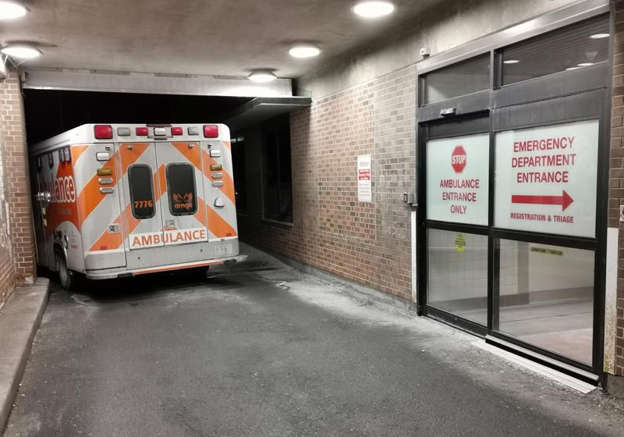Alberta
Province adding 22 ambulance crews including 1 in Red Deer

Adding new EMS supports to improve response times
Record investments will build a stronger, more flexible and innovative system for emergency medical services (EMS) with better access to care and shorter wait times.
Alberta’s government promised that help is on the way for Albertans and the province’s health system. By hiring more staff, putting more ambulances on the road and strengthening mental health supports for front-line workers, Alberta’s government is delivering on that promise.
“We are adding new ambulances and front-line staff and investing in solutions now and into the future to make sure ambulances arrive as fast as possible when Albertans call 911 for a medical emergency.”
The funding boost also supports implementing Health Care Action Plan priorities and recommendations made by the Alberta EMS Provincial Advisory Committee to improve EMS response and the work culture for EMS staff.
Alberta has the best front-line health care workers in the world, and Budget 2023 will put the right supports in place to ensure Albertans get the care they need, when and where they need it.
“Budget 2023 delivers the needed support to the front line and adds more resources to implement the Alberta EMS Provincial Advisory Committee recommendations. The additional funding will help ease worker fatigue and provide more mental health supports to improve the work environment for all EMS staff.”
Adding EMS staff and more ambulances
To improve EMS response time, Budget 2023 invests in adding staff and boosting the number of ambulances on the road. The funding increase will add EMS crews to staff 10 more ambulances in Edmonton, 10 in Calgary, one in Lethbridge and one in Red Deer during peak hours this year.
As part of the ongoing work to improve the central dispatch system and implement the EMS advisory committee’s recommendations, Alberta’s government will provide more than $1.5 million to hire and train additional staff and conduct a review of EMS available resources and how they are used in communities.
Supporting EMS workforce
Front-line staff and community partners asked for more supports to create better work environments, as reflected in the provincial advisory committee’s recommendations. Budget 2023 delivers funding to improve scheduling practices to allow for more breaks, more flexibility in the length of shifts and opportunities to take time off, in addition to providing for more training and development opportunities.
Nearly $1 million will go towards boosting mental health supports for EMS staff across the province. A $3-million investment will address paramedic fatigue in rural communities by adjusting work hours and shift schedules as part of the AHS EMS hours of work initiative.
“This funding increase enables aggressive action on our priority of improving emergency response times. We will hire more staff, increase hours of ambulance capacity, expand partnerships with other community supports and deliver innovative projects. This is about getting Albertans the care they need, where and when they need it.”
EMS-811 shared response, inter-facility transfers and treat and refer
Alberta’s Health Care Action Plan is helping to speed up EMS response times and free up highly trained paramedics from non-emergency calls and transfers. Additional funding will go towards the EMS-811 Shared Response program that transfers calls from Albertans with non-urgent conditions to registered nurses with Health Link.
All these actions will reduce EMS response time by empowering paramedics to focus efforts on urgent calls and diverting them away from situations when their level of care is not medically required.
Medical first response supports in rural communities
Medical first responders provide life-saving care in rural and remote communities until an ambulance arrives. Budget 2023 invests in supporting medical first response and implementing the EMS provincial advisory committee’s recommendations to add capacity and provide additional training and equipment.
Budget 2023 secures Alberta’s future by transforming the health care system to meet people’s needs, supporting Albertans with the high cost of living, keeping our communities safe and driving the economy with more jobs, quality education and continued diversification.
Quick facts
In 2023-24, Alberta’s government is providing $723 million in operating funds for EMS, an increase of $138 million to support EMS priority actions, including:
- $47 million for additional EMS capacity to put more ambulances on the road, hire additional paramedics and emergency communications officers, and create dedicated inter-facility transfer capacity in Edmonton, Calgary and Red Deer.
- $24 million for recruitment and workforce initiatives and supports, including training programs and mental health supports for front-line staff.
- $24 million to continue initiatives that were implemented last year such as the 19 additional ambulances in Calgary and Edmonton, and enhanced scheduling changes made in high-priority stations around the province to reduce paramedic fatigue.
- $21 million for ground ambulance contract changes, increased mileage and fuel, including for air ambulance/air ambulance supports and other operational pressures from the increase in the number of events.
- $7 million to support strategies to enhance the EMS system, such as enhancements to the medical first response program, public education and response, and a review of the ground ambulance resource allocation policies and capacity.
- Almost $7 million to support other initiatives such as clinical improvement initiatives like expanding the vital health response program to the south zone, which will make it possible for paramedics to provide life-saving heart medication in the event of a heart attack, and expanding the mobile integrated heart program to support community paramedics across the province.
- $3 million for the EMS-811 Shared Response program.
- $3 million for other initiatives related to implementing recommendations.
- $2 million for a project related to air ambulances.
- Budget 2023 provides $196 million in new EMS funding over three years to hire more staff, put more ambulances on the road and implement recommendations made by the EMS advisory committee and the EMS Dispatch Review Report.
- In addition, $15 million over three years will fund a new capital program to purchase more ambulances and related equipment.
Alberta
Alberta’s grand bargain with Canada includes a new pipeline to Prince Rupert

From Resource Now
Alberta renews call for West Coast oil pipeline amid shifting federal, geopolitical dynamics.
Just six months ago, talk of resurrecting some version of the Northern Gateway pipeline would have been unthinkable. But with the election of Donald Trump in the U.S. and Mark Carney in Canada, it’s now thinkable.
In fact, Alberta Premier Danielle Smith seems to be making Northern Gateway 2.0 a top priority and a condition for Alberta staying within the Canadian confederation and supporting Mark Carney’s vision of making Canada an Energy superpower. Thanks to Donald Trump threatening Canadian sovereignty and its economy, there has been a noticeable zeitgeist shift in Canada. There is growing support for the idea of leveraging Canada’s natural resources and diversifying export markets to make it less vulnerable to an unpredictable southern neighbour.
“I think the world has changed dramatically since Donald Trump got elected in November,” Smith said at a keynote address Wednesday at the Global Energy Show Canada in Calgary. “I think that’s changed the national conversation.” Smith said she has been encouraged by the tack Carney has taken since being elected Prime Minister, and hopes to see real action from Ottawa in the coming months to address what Smith said is serious encumbrances to Alberta’s oil sector, including Bill C-69, an oil and gas emissions cap and a West Coast tanker oil ban. “I’m going to give him some time to work with us and I’m going to be optimistic,” Smith said. Removing the West Coast moratorium on oil tankers would be the first step needed to building a new oil pipeline line from Alberta to Prince Rupert. “We cannot build a pipeline to the west coast if there is a tanker ban,” Smith said. The next step would be getting First Nations on board. “Indigenous peoples have been shut out of the energy economy for generations, and we are now putting them at the heart of it,” Smith said.
Alberta currently produces about 4.3 million barrels of oil per day. Had the Northern Gateway, Keystone XL and Energy East pipelines been built, Alberta could now be producing and exporting an additional 2.5 million barrels of oil per day. The original Northern Gateway Pipeline — killed outright by the Justin Trudeau government — would have terminated in Kitimat. Smith is now talking about a pipeline that would terminate in Prince Rupert. This may obviate some of the concerns that Kitimat posed with oil tankers negotiating Douglas Channel, and their potential impacts on the marine environment.
One of the biggest hurdles to a pipeline to Prince Rupert may be B.C. Premier David Eby. The B.C. NDP government has a history of opposing oil pipelines with tooth and nail. Asked in a fireside chat by Peter Mansbridge how she would get around the B.C. problem, Smith confidently said: “I’ll convince David Eby.”
“I’m sensitive to the issues that were raised before,” she added. One of those concerns was emissions. But the Alberta government and oil industry has struck a grand bargain with Ottawa: pipelines for emissions abatement through carbon capture and storage.
The industry and government propose multi-billion investments in CCUS. The Pathways Alliance project alone represents an investment of $10 to $20 billion. Smith noted that there is no economic value in pumping CO2 underground. It only becomes economically viable if the tradeoff is greater production and export capacity for Alberta oil. “If you couple it with a million-barrel-per-day pipeline, well that allows you $20 billion worth of revenue year after year,” she said. “All of a sudden a $20 billion cost to have to decarbonize, it looks a lot more attractive when you have a new source of revenue.” When asked about the Prince Rupert pipeline proposal, Eby has responded that there is currently no proponent, and that it is therefore a bridge to cross when there is actually a proposal. “I think what I’ve heard Premier Eby say is that there is no project and no proponent,” Smith said. “Well, that’s my job. There will be soon. “We’re working very hard on being able to get industry players to realize this time may be different.” “We’re working on getting a proponent and route.”
At a number of sessions during the conference, Mansbridge has repeatedly asked speakers about the Alberta secession movement, and whether it might scare off investment capital. Alberta has been using the threat of secession as a threat if Ottawa does not address some of the province’s long-standing grievances. Smith said she hopes Carney takes it seriously. “I hope the prime minister doesn’t want to test it,” Smith said during a scrum with reporters. “I take it seriously. I have never seen separatist sentiment be as high as it is now. “I’ve also seen it dissipate when Ottawa addresses the concerns Alberta has.” She added that, if Carney wants a true nation-building project to fast-track, she can’t think of a better one than a new West Coast pipeline. “I can’t imagine that there will be another project on the national list that will generate as much revenue, as much GDP, as many high paying jobs as a bitumen pipeline to the coast.”
Alberta
Albertans need clarity on prime minister’s incoherent energy policy

From the Fraser Institute
By Tegan Hill
The new government under Prime Minister Mark Carney recently delivered its throne speech, which set out the government’s priorities for the coming term. Unfortunately, on energy policy, Albertans are still waiting for clarity.
Prime Minister Carney’s position on energy policy has been confusing, to say the least. On the campaign trail, he promised to keep Trudeau’s arbitrary emissions cap for the oil and gas sector, and Bill C-69 (which opponents call the “no more pipelines act”). Then, two weeks ago, he said his government will “change things at the federal level that need to be changed in order for projects to move forward,” adding he may eventually scrap both the emissions cap and Bill C-69.
His recent cabinet appointments further muddied his government’s position. On one hand, he appointed Tim Hodgson as the new minister of Energy and Natural Resources. Hodgson has called energy “Canada’s superpower” and promised to support oil and pipelines, and fix the mistrust that’s been built up over the past decade between Alberta and Ottawa. His appointment gave hope to some that Carney may have a new approach to revitalize Canada’s oil and gas sector.
On the other hand, he appointed Julie Dabrusin as the new minister of Environment and Climate Change. Dabrusin was the parliamentary secretary to the two previous environment ministers (Jonathan Wilkinson and Steven Guilbeault) who opposed several pipeline developments and were instrumental in introducing the oil and gas emissions cap, among other measures designed to restrict traditional energy development.
To confuse matters further, Guilbeault, who remains in Carney’s cabinet albeit in a diminished role, dismissed the need for additional pipeline infrastructure less than 48 hours after Carney expressed conditional support for new pipelines.
The throne speech was an opportunity to finally provide clarity to Canadians—and specifically Albertans—about the future of Canada’s energy industry. During her first meeting with Prime Minister Carney, Premier Danielle Smith outlined Alberta’s demands, which include scrapping the emissions cap, Bill C-69 and Bill C-48, which bans most oil tankers loading or unloading anywhere on British Columbia’s north coast (Smith also wants Ottawa to support an oil pipeline to B.C.’s coast). But again, the throne speech provided no clarity on any of these items. Instead, it contained vague platitudes including promises to “identify and catalyse projects of national significance” and “enable Canada to become the world’s leading energy superpower in both clean and conventional energy.”
Until the Carney government provides a clear plan to address the roadblocks facing Canada’s energy industry, private investment will remain on the sidelines, or worse, flow to other countries. Put simply, time is up. Albertans—and Canadians—need clarity. No more flip flopping and no more platitudes.
-

 Business1 day ago
Business1 day agoEU investigates major pornographic site over failure to protect children
-

 Health2 days ago
Health2 days agoRFK Jr. purges CDC vaccine panel, citing decades of ‘skewed science’
-

 Courageous Discourse2 days ago
Courageous Discourse2 days agoHealthcare Blockbuster – RFK Jr removes all 17 members of CDC Vaccine Advisory Panel!
-

 Censorship Industrial Complex2 days ago
Censorship Industrial Complex2 days agoAlberta senator wants to revive lapsed Trudeau internet censorship bill
-

 Immigration2 days ago
Immigration2 days agoMass immigration can cause enormous shifts in local culture, national identity, and community cohesion
-

 Canadian Energy Centre1 day ago
Canadian Energy Centre1 day agoCross-Canada economic benefits of the proposed Northern Gateway Pipeline project
-

 Economy1 day ago
Economy1 day agoCarney’s Promise of Expediting Resource Projects Feels Like a Modern Version of the Wicked Stepmother from Disney’s Cinderella
-

 Health2 days ago
Health2 days agoPolice are charging parents with felonies for not placing infants who died in sleep on their backs






